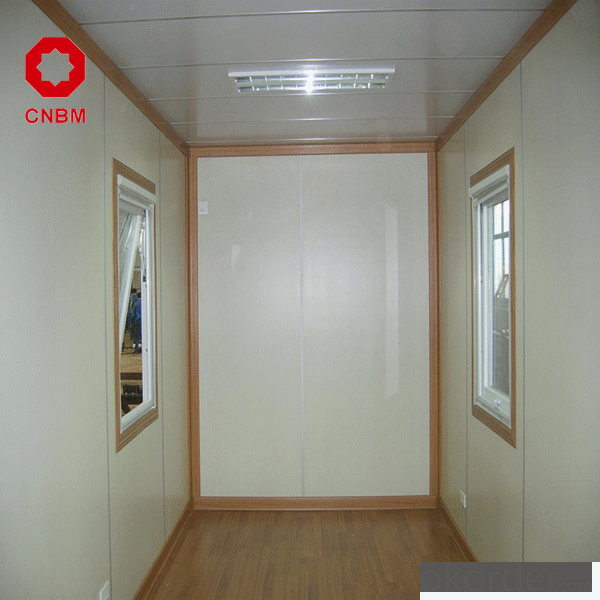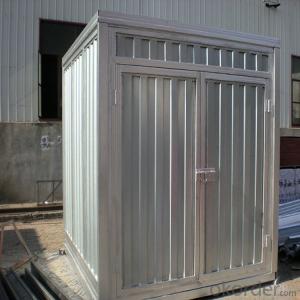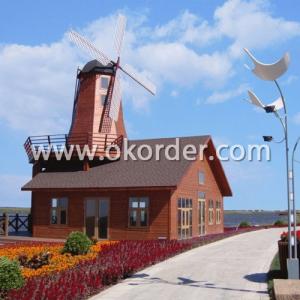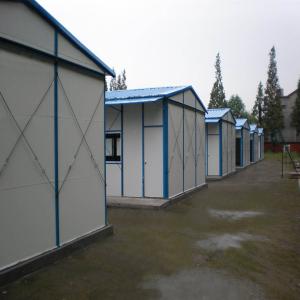Good Quality Galvanzied Steel Storage of CNBM
- Loading Port:
- Tianjin
- Payment Terms:
- TT OR LC
- Min Order Qty:
- 6 set
- Supply Capability:
- 50000 set/month
OKorder Service Pledge
OKorder Financial Service
You Might Also Like
Good Quality Galvanzied Steel Storage of CNBM
Description:
1. The house is made of light steel structure and rustproof color steel sandwich panel as wall and roof.
2. The size and layout can be designed as per customers' requirements for its flexible dimension
3. The house has waterproof structure and heating insulation material, such as EPS, Rock wool or PU Panels interlock easily to form a complete thermally efficient shell.
4. Two kinds of flooring system are available, one is steel chassis floor, the other is concrete foundation.
5. One 40’HQ container can load about 160m2 considering 75mm thickness panel for roof and wall;
6. Six skilled workers can finish 42m2 in 8 hours ;
7. The house can resist heavy wind load of 0.5KN/m2 and 7-8 degree seismic intensity.
8. DimensionAs per customer design or layoutLoading160 to 200m2 per 40’HQ container
Applications:
Family house for low income people, Temporary homes for disaster area, Holiday and vocation house…Remote site constructions camping, Warehouse , Work shop…Company office, Dining halls, Dormitories, Hospitals, Saloons, Entertainment centers…
FAQ:
1.How about the installation? For example, the time and cost?
To install 200sqm house needs only 45 days by 6 professional workers. The salary of enginner is USD150/day, and for workers, it's 100/day.
2.How long is the life span of the house?
Around 50 years
3. And what about the loading quantity?
One 40'container can load 140sqm of house.
Images:



- Q:Are container houses suitable for areas with high humidity?
- Yes, container houses can be suitable for areas with high humidity. However, proper insulation and ventilation systems should be in place to prevent issues such as condensation and mold growth. Additionally, using appropriate materials and building techniques can help mitigate the impact of high humidity on the structure.
- Q:Can container houses be designed to have a walk-in closet?
- Certainly, walk-in closets can absolutely be included in the design of container houses. The dimensions of the closet may vary depending on the size of the container, but it is definitely feasible to incorporate this feature. By carefully planning and making efficient use of the available space, a container house can provide a practical and visually appealing walk-in closet. Additionally, customization options such as the installation of shelves, hanging rods, shoe racks, drawers, and mirrors can further enhance the functionality and storage capacity of the closet. Ultimately, the design and layout of a container house can be personalized to cater to individual preferences and requirements, including the inclusion of a walk-in closet.
- Q:Are container houses suitable for Airbnb investment properties?
- Container houses can be a great option for Airbnb investment properties for several reasons. First, container houses are known for their unique and modern design, which can attract a wide range of guests looking for a memorable and Instagram-worthy experience. These houses often have a sleek and minimalist aesthetic, making them appealing to younger travelers who prefer trendy and unconventional accommodations. Additionally, container houses are typically more cost-effective to build compared to traditional houses, which can be advantageous for investors seeking higher returns on their investment. Moreover, the construction process for container houses is usually faster, allowing investors to start generating income from their Airbnb property sooner. Furthermore, container houses are highly customizable and can be designed to accommodate various amenities and features that guests look for in an Airbnb listing. From fully-equipped kitchens to comfortable living spaces and even outdoor areas, container houses can be transformed into cozy and functional spaces that provide a comfortable stay for guests. In terms of sustainability, container houses are often built using repurposed shipping containers, which helps reduce waste and promote eco-friendly practices. This can be an attractive aspect for environmentally conscious guests who prioritize sustainable travel options. However, it is important to consider the location and target market when investing in container houses for Airbnb. Some areas may have stricter regulations or restrictions regarding container houses, so thorough research and understanding of local regulations are necessary. In conclusion, container houses can be a suitable investment for Airbnb properties due to their unique design, cost-effectiveness, customizability, and potential appeal to a wide range of guests. However, careful consideration of location and local regulations is crucial to ensure a successful investment.
- Q:What are the disadvantages of living in a container house?
- Living in a container house has its fair share of drawbacks. One primary disadvantage is the limited space within the container. Originally designed for shipping, containers are typically small and cramped, posing a challenge for individuals or families in need of more living area. This can make furniture arrangement and storage difficult, requiring creative use of available space. Furthermore, container houses may lack proper insulation, resulting in extreme temperatures indoors. In hot summer months, the containers can become unbearably hot, necessitating additional cooling systems. Conversely, during colder seasons, the lack of insulation makes it challenging to maintain a comfortable indoor temperature, requiring extra heating sources. Another drawback is the limited natural light that enters the container. Small windows make the space feel dark and gloomy. This lack of natural light can negatively affect mood and productivity, often requiring artificial lighting throughout the day. Privacy can also be a concern in container houses. Due to their design, containers offer limited soundproofing capabilities, allowing noise from outside or neighboring containers to easily penetrate the living space. This lack of privacy can be a significant drawback for those who value a peaceful living environment. Moreover, obtaining permits and meeting building regulations can be a more arduous task for container houses. Areas often have strict zoning laws and building codes that may not align easily with container housing. This can lead to a longer and more complex process to gain necessary approvals, potentially resulting in delays and higher costs. Lastly, the resale value of container houses may be lower compared to traditional houses. As container houses are still relatively new and unconventional, there may be less demand from potential buyers. This can make it challenging to recoup the initial investment or make a profit if the property is sold in the future. In conclusion, container houses offer unique and environmentally friendly living options, but they come with their fair share of drawbacks, including limited space, insulation issues, lack of natural light, privacy concerns, challenges in obtaining permits, and potentially lower resale value. It is crucial to carefully consider these disadvantages before deciding to live in a container house.
- Q:Are container houses suitable for college dormitories?
- Yes, container houses can be suitable for college dormitories. Container houses are essentially repurposed shipping containers that have been converted into living spaces. They offer several advantages that make them a viable option for college dormitories. Firstly, container houses are cost-effective. They are much cheaper to build and maintain compared to traditional construction methods. This makes them an affordable option for colleges and universities, especially those that are looking to expand their housing capacity without breaking the bank. Secondly, container houses are eco-friendly. By repurposing shipping containers, we reduce waste and give a second life to these structures. Additionally, container houses can be designed to be energy-efficient, by incorporating features such as insulation, solar panels, and rainwater harvesting systems. This aligns with the sustainability goals of many educational institutions. Furthermore, container houses can be easily customized and adapted to fit the specific needs of college students. They can be designed to accommodate multiple individuals, with separate sleeping areas, shared living spaces, and communal amenities like kitchens and bathrooms. The modular nature of container houses also allows for flexibility in layout and expansion as the college's housing needs change over time. Container houses also offer a quick construction time. Once the design is finalized, container houses can be built off-site and then transported to the college campus. This reduces disruption to campus life and minimizes construction time, allowing for faster deployment of additional dormitories. Lastly, container houses can be aesthetically appealing. With creative design and architectural features, container houses can be transformed into modern and stylish living spaces. This can help create a positive and welcoming environment for college students. While there may be challenges to overcome, such as ensuring proper insulation and addressing any structural concerns, container houses have the potential to be a suitable and practical solution for college dormitories. Their cost-effectiveness, eco-friendliness, customization options, quick construction time, and potential for aesthetic appeal make them a compelling choice for educational institutions seeking to provide affordable and sustainable housing options for their students.
- Q:Can container houses be designed with a loft or mezzanine?
- Yes, container houses can be designed with a loft or mezzanine. The modular nature of shipping containers allows for flexible design options, including the incorporation of additional levels or platforms. By utilizing clever structural solutions, such as staircases or ladders, container houses can maximize vertical space and create stylish and functional lofts or mezzanines.
- Q:Can container houses be designed with earthquake-resistant foundation systems?
- Indeed, it is possible to design container houses with foundation systems that are resistant to earthquakes. In fact, container houses have proven to be quite resilient in seismic events due to their strong structure and ability to withstand lateral forces. To enhance their resistance to earthquakes, container houses can be constructed on a foundation system that is both sturdy and flexible. This may involve the use of deep concrete footings or piers that are specifically designed to absorb and distribute the seismic energy generated during an earthquake. These footings can be strategically placed at key points along the container house structure to provide stability and prevent any potential damage. Moreover, engineers can employ innovative design techniques to further improve the earthquake resistance of container houses. This can include the incorporation of reinforced steel frames within the container structure, as well as the implementation of bracing systems to add strength and stability. Additionally, container houses can be designed in compliance with specific seismic codes and regulations. These codes ensure that the container house meets the required standards for earthquake resistance, taking into consideration factors such as the location, soil conditions, and anticipated seismic activity of the area. Overall, container houses can indeed be designed with earthquake-resistant foundation systems, making them a practical and secure choice for regions prone to seismic activity.
- Q:Can container houses withstand extreme weather conditions?
- Yes, container houses can withstand extreme weather conditions. Due to their sturdy steel structure, they are designed to be durable and resistant to harsh weather, including strong winds, heavy rains, and even earthquakes. Additionally, proper insulation and reinforcement can be added to further enhance their ability to withstand extreme weather conditions.
- Q:Are container houses suitable for tiny house living?
- Tiny house living can indeed be suitable for container houses. Constructed using shipping containers, these homes boast sturdiness, durability, and easy transportability. They bring forth numerous advantages when it comes to tiny house living. First and foremost, container houses are cost-effective. Compared to conventional building materials, shipping containers are reasonably priced and easily accessible. This makes them an affordable choice for individuals seeking a tiny house lifestyle. Secondly, container houses offer immense customization opportunities. By employing some creativity and craftsmanship, shipping containers can be transformed into functional and comfortable living spaces. They can be designed to accommodate all essential amenities, including kitchens, bathrooms, bedrooms, and living areas. Furthermore, container houses are environmentally friendly. By repurposing shipping containers, we contribute to waste reduction and the recycling of materials that would otherwise remain unused. This renders container houses an environmentally sustainable option for tiny house living. Moreover, container houses are portable. The transportability of shipping containers allows for easy relocation to different areas, granting the ability to change scenery or move without undertaking the construction of an entirely new house. Nevertheless, it is essential to consider potential challenges. Container houses may require insulation to regulate temperature, as metal containers can be susceptible to extreme heat or cold. Additionally, the size of shipping containers may limit space for certain individuals or families, as they typically provide less room than other tiny house designs. To conclude, container houses offer a suitable alternative for tiny house living. They offer affordability, customization possibilities, sustainability, and portability. However, it is crucial to carefully evaluate personal needs and requirements before determining whether a container house is the ideal choice.
- Q:What is the meaning of goods warehousing?
- The traditional definition of warehousing is given from the perspective of material reserves
1. Manufacturer Overview |
|
|---|---|
| Location | |
| Year Established | |
| Annual Output Value | |
| Main Markets | |
| Company Certifications | |
2. Manufacturer Certificates |
|
|---|---|
| a) Certification Name | |
| Range | |
| Reference | |
| Validity Period | |
3. Manufacturer Capability |
|
|---|---|
| a)Trade Capacity | |
| Nearest Port | |
| Export Percentage | |
| No.of Employees in Trade Department | |
| Language Spoken: | |
| b)Factory Information | |
| Factory Size: | |
| No. of Production Lines | |
| Contract Manufacturing | |
| Product Price Range | |
Send your message to us
Good Quality Galvanzied Steel Storage of CNBM
- Loading Port:
- Tianjin
- Payment Terms:
- TT OR LC
- Min Order Qty:
- 6 set
- Supply Capability:
- 50000 set/month
OKorder Service Pledge
OKorder Financial Service
Similar products
New products
Hot products
Related keywords




























